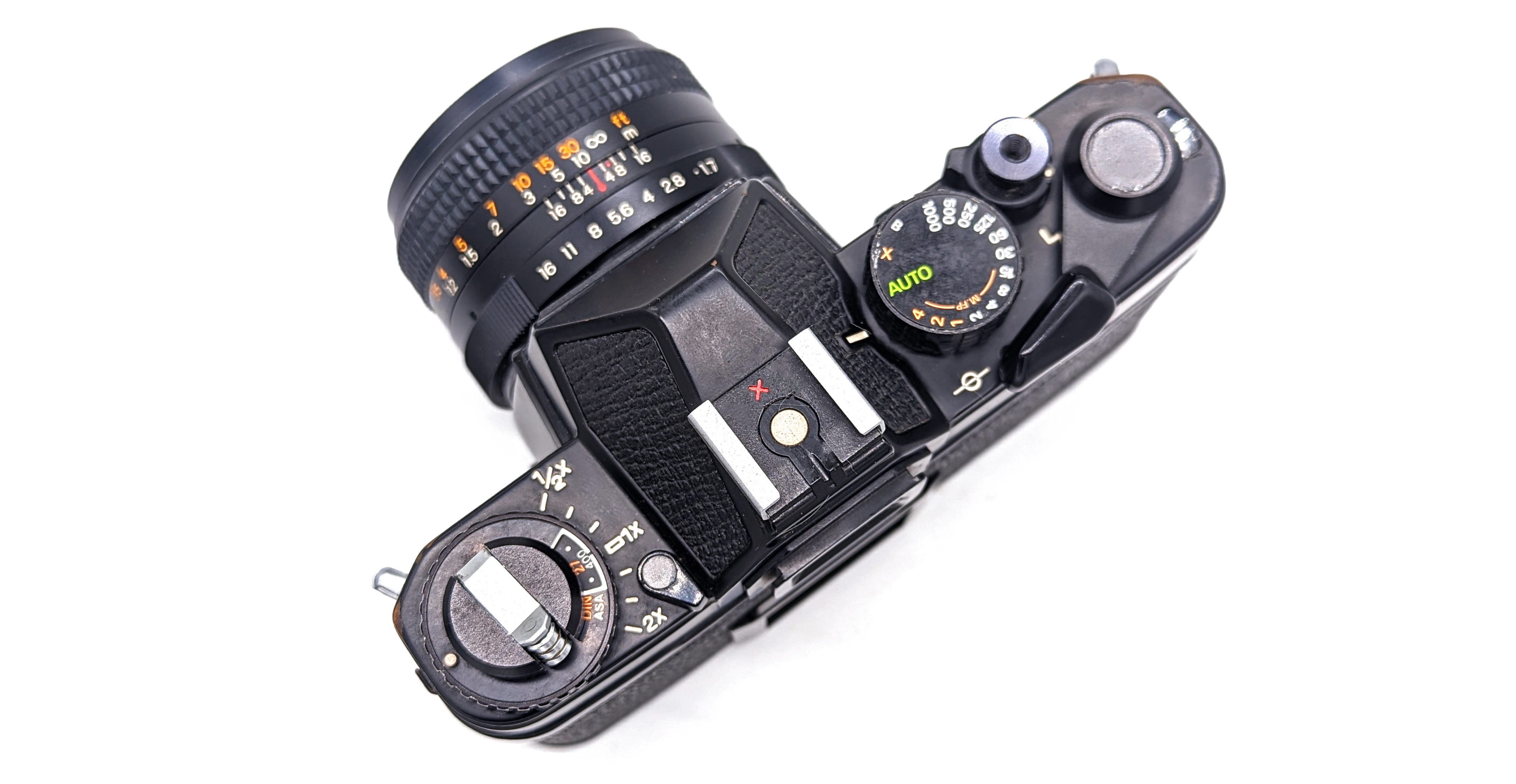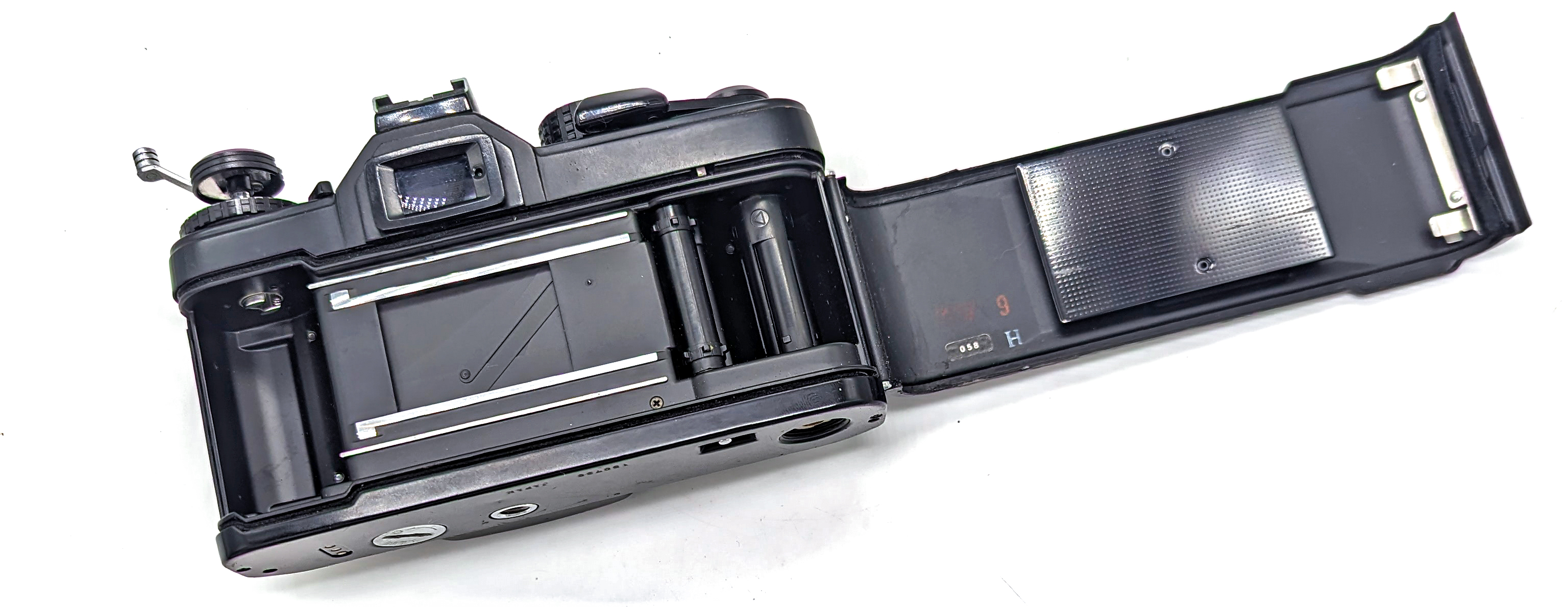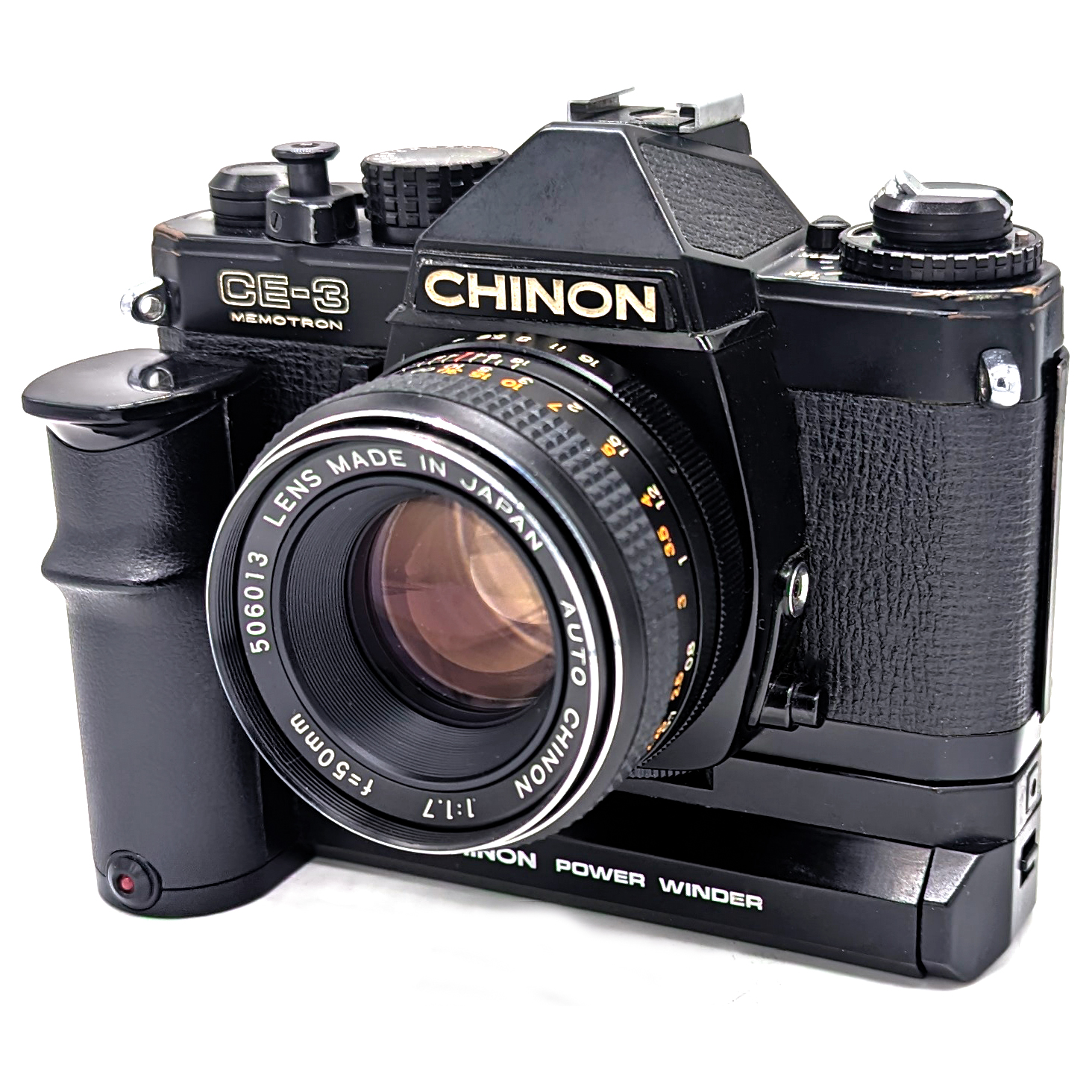
The 1978 Chinon CE-3 Memotron (aka the “Revueflex AC1”) is one of a handful of M42 camera bodies that provide a kind of primitive aperture-priority autoexposure capability with all auto-diaphragm lenses, regardless of manufacturer. Being one of the last “new” M42 bodies introduced, it is also the most advanced. In my opinion, it is the best, overall, M42 body of the film body.
By the mid-1960s, M42 camera manufacturers began working on a technical solution to eliminate the “two-step” stop-down process required for TTL light metering. In other words, the goal was to have the camera body be able to read the selected lens aperture for metering purposes while keeping the aperture wide open for focusing and composition purposes. By the early 1970s, most manufacturers solved this issue by developing proprietary mechanical or electric linkages between the lenses and bodies so that the two could “communicate.” Pentacon’s 1968 “Super” appears to have been the first to market with this fourth generation technology. Just a few years later, Pentax went in a different direction, combining an electronic shutter with its own proprietary lenses to achieve aperture-priority autoexposure in what would become the fifth generation.
Cosina and Chinon took a third approach. Instead of using a proprietary lens system, they developed a type of electronic-shutter, aperture-priority autoexposure system where the shutter button itself would act as the “stop down” metering switch. With any M42 lens with auto-diaphragm operation, you would select “Auto” on the shutter speed dial and select an aperture on the lens. When you press the shutter button half-way down, the camera stops the lens down to the selected aperture (darkening the viewfinder), and the viewfinder displays the shutter speed for the aperture selected. Pressing the shutter button all the way down would then trip the shutter.
The cameras with this “autoexposure” feature included the Cosina Hi-Lite EC (1972), the Chinon CE (1974), the Chinon CE-II (1976), the Cosina Hi-Lite ECL (1977), and the Chinon CE-3 (1978). Many of these models also were marketed (often with some minor cosmetic changes) under the Revueflex, Petri, or Porst brand names. The Hi-Lite EC, the Hi-Lite ECL, the CE, and the CE-II all had a top shutter speeds of 1/2000, which was as fast as SLRs got in the 1970s. The primary difference between the two systems was that Chinon used a spring in the shutter button that would return the lens to wide open when the half-press was released. Cosina models did not contain this spring and required the pressing of an external button to return the lens to wide open.
The CE-3 lost the top 1/2000 top speed but further improved upon the CE-II with better focusing aids in the viewfinder, better viewfinder coverage and brightness, a provision for a motor drive, the use of silver oxide 1.5V batteries instead of a 6V battery, a slightly higher flash sync, all in a smaller and lighter body. The CE-3 was often bundled for sale with, I believe, a 50mm f/1.7 or 55mm f/1.4 Chinon lens. The Revueflex AC1 is essentially the same camera as the CE-3 with some inconsequential cosmetic differences.

Specifications
| Lens Mount | M42 |
| Shutter | Seiko Electronic Vertical Metal |
| Shutter Speeds | 4 sec. to 1/1000 (Continuously Variable) |
| Viewfinder Coverage | 95% |
| Flash Sync | 1/100 |
| Exposure Lock? | Yes |
| ASA Range | 25-3200 |
| Meter | TTL Center-Weighted Silicon Type |
| Batteries | 2 x SR44 |
| Weight (Body Only) | 620g |

Operation
In addition to the useful autoexposure system described above, the CE-3 pretty much checks all of the boxes for what a mid-range 1970s SLR could do. It is fairly small-bodied, like contemporary cameras such as the Nikon FM.
Exposure Lock: Always a nice feature on any camera, the CE-3 has an exposure lock that operates via a button on the side of the lens. In operation, you would half-depress the shutter, push in the AE lock button, reframe and take the shot.
Exposure Compensation: Via a dial on the top left, exposure compensation can manually be inputted to +/- 1 stop in 1/3 stop increments. One of the significant differences between the AC1 and the CE-3 is found with the way this dial works. On the AC1, the dial itself has the entire range of ASA speeds, which is then rotated to a white dot for the desired film speed. On the CE-3, the ASA selection is the more traditional windowed type. With both, the main dial is rotated to the appropriate exposure compensation spot.
Viewfinder: The CE-3 has a nice, but not professional, viewfinder with 95% coverage. It uses a non-swappable focusing screen with a split image with a microprism surrounding it. Shutter speeds are displayed on the left part of the screen with match-needle operation. If the batteries are working, a green light will illuminate in the outside viewfinder frame to remind you that the batteries are working.
Shutter Lock: Via a switch around the shutter speed button, the shutter can be locked to prevent accidentally triggering.
Batteries: The CE-3 uses cheap button-style silver oxide SR44 batteries. It will also work fine with the equivalent alkalines.
Shutter: The CE-3’s stepless electronic shutter is not very quiet or dampened, par for the course with 1970s consumer SLRs.
Flash Sync Speed: 1/100 is par for the course for the era.
Self-Timer: & Flash Hot Shoe Yes.

The Motor Drive
The CE-3 has an optional “Power Winder” that uses AA batteries and screws in to the bottom of the camera. Unlike most 1970s consumer motor drives which simply permitted continuous shooting at about 1.5-2.5 frames per second (tops), the Power Winder had several different functions operated by rotating switches. First, it had a “single” versus “continuous” (2 fps) mode. Second, it had a pre-set counter which would permit the camera to continuously fire until a certain number of selected frames was reached (up to 24). Finally, there was an “interval timer” which permitted the automatic firing of the camera at up to 30 seconds apart. The Power Winder also provides a nice built-in grip for the camera as well. It was rebadged in connection with the AC1 as the “Revue Motor 35.” Both the Power Winder and the Revue Motor 35 are interchangeable. The Power Winder could also be used on the Chinon CM-3. Do not leave the drive ON when not in use as it will drain the batteries even if not actively being used.
 |  |
Differences Between the CE-3 and the AC1
The CE-3 (top) and the AC1 (bottom) are not exactly the same camera. However, the only apparent differences can be found in design of the top plate and the layout of some of the controls. While the shutter dial and shutter button are the same, the film advance lever, exposure compensation dial, ASA selection, film counter window, prism shape, rewind dial, and the hot shoe are not. The rest of the camera body, including the viewfinder and electronics, are exactly the same.


Conclusions
If you enjoy using a wide variety of M42 lenses from different manufacturers with the option of aperture-priority autoexposure, in my opinion, the Chinon CE-3 is the best overall option. Other M42 cameras might surpass some of its features individually (higher shutter speed, brighter viewfinder, higher flash sync, etc.), but not as a package.
Hi, i have a Chinon CE-5 in my collection. Over time with a lot effort i manage to purchase the orginal “data-back” (db-010 & dp-520) and “infrared autofocus lens”.
My question is, who were the developers (patents) behind these unique and for those days sophisticated accessoires from Chinon…?
Kind regards Vlad
[…] made, a huge step giftware. The tank-like CE and CE II Memotrons led to the smaller, less imposing CE-3 and eventually the K-mount CE-4 in […]